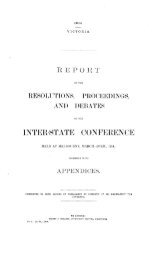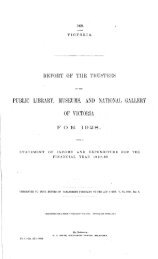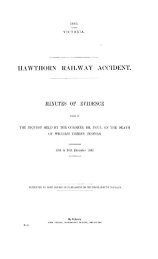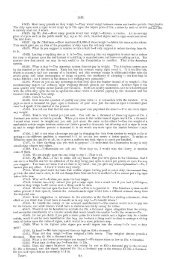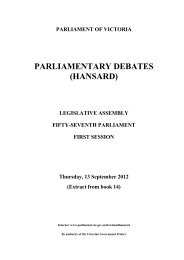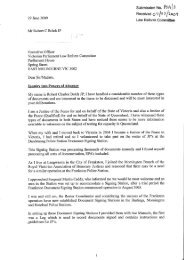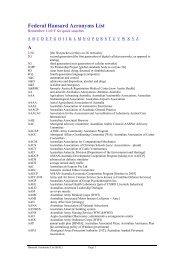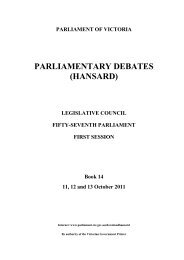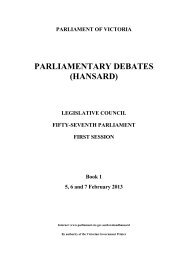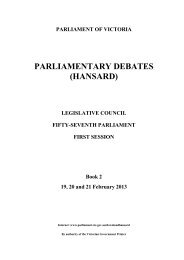Book 8 - Parliament of Victoria
Book 8 - Parliament of Victoria
Book 8 - Parliament of Victoria
Create successful ePaper yourself
Turn your PDF publications into a flip-book with our unique Google optimized e-Paper software.
AUSTRALIAN SYNCHROTRON: FUNDING<br />
Wednesday, 1 June 2011 COUNCIL 1641<br />
does not control the levers which influence the nation’s<br />
macroeconomic performance. I thus know he cannot be<br />
blamed for the high Australian dollar, the resources<br />
boom and the two-speed economy. However, I also<br />
know that the minister and the Baillieu government<br />
have tools at their disposal to help cushion the blow <strong>of</strong><br />
the high Australian dollar, and I think that is lost on<br />
Mr Dalla-Riva because he keeps referring to the high<br />
Australian dollar. I know the dollar is high, and I know<br />
Mr Dalla-Riva does not control the level <strong>of</strong> our<br />
currency, but he and the state government have tools at<br />
their disposal to cushion the impact <strong>of</strong> the high<br />
currency.<br />
What I do not know is why the government is sitting<br />
back and allowing our manufacturing sector to drift.<br />
The government cannot do this for long. It cannot sit<br />
back and allow our manufacturers to go to the wall. The<br />
historically high level <strong>of</strong> the Australian dollar requires<br />
the government to take a more proactive approach to<br />
the manufacturing sector in order to cushion the impact<br />
<strong>of</strong> the currency’s high level. The Baillieu government<br />
and Mr Dalla-Riva need an urgent and serious policy<br />
response, and they need it now because <strong>of</strong> the high<br />
Australian dollar. The government needs to quickly<br />
develop a plan.<br />
Allowing the manufacturing sector to drift while<br />
allowing the bureaucracy to come up with a plan for the<br />
manufacturing sector through the <strong>Victoria</strong>n<br />
Competition and Efficiency Commission process is<br />
simply not good enough. <strong>Victoria</strong>n manufacturers and<br />
<strong>Victoria</strong>ns employed in the manufacturing sector are<br />
nervously waiting for leadership from this government.<br />
I would not want to be a manufacturer or to be working<br />
in the manufacturing industry at the moment, because<br />
there is a huge vacuum in leadership on the part <strong>of</strong><br />
government in relation to the manufacturing sector.<br />
The <strong>Victoria</strong>n manufacturing sector is waiting for a<br />
statement on government purchasing policy that would<br />
benefit our manufacturing industry. It is waiting for a<br />
commitment that our manufacturers will benefit from<br />
ongoing acquisitions for <strong>Victoria</strong>’s public transport<br />
services, such as trams. It is waiting for a commitment<br />
on payroll tax relief. It is waiting for a plan. It is waiting<br />
for a policy. Any one <strong>of</strong> the things I have just<br />
mentioned — or maybe any two <strong>of</strong> them — would<br />
build confidence in local manufacturing, underpin<br />
access to financial investment and perhaps increase job<br />
retention levels.<br />
You cannot take a fatalistic view on this. You cannot<br />
put your hands up in the air as Mr Dalla-Riva seems to<br />
do and say, ‘I cannot control the level <strong>of</strong> the Australian<br />
dollar, so I am disempowered’. No. The minister has<br />
power and has been in power. He has tools at his<br />
disposal to cushion the blow <strong>of</strong> the high Australian<br />
dollar. It is about time Mr Dalla-Riva worked that out.<br />
None <strong>of</strong> those things were mentioned in the budget.<br />
Furthermore, the word ‘jobs’ was not mentioned once.<br />
The budget was a missed opportunity to assist and<br />
inspire confidence in our manufacturing sector. Not<br />
only was it a missed opportunity to assist this besieged<br />
sector but as it turns out the budget became an<br />
opportunity for the government to strike a further blow<br />
against our manufacturing sector by failing to provide<br />
funds for the Australian Synchrotron.<br />
Innovation and the consequent improvements in<br />
productivity are critical for the survival <strong>of</strong> the <strong>Victoria</strong>n<br />
manufacturing sector. According to Australian Bureau<br />
<strong>of</strong> Statistics data, Australian businesses that innovate<br />
are twice as likely to report increased productivity and<br />
63 per cent more likely to report increased pr<strong>of</strong>itability<br />
than businesses that do not innovate. According to<br />
page 198 <strong>of</strong> the Economic Development and<br />
Infrastructure Committee’s report <strong>of</strong> its inquiry into<br />
manufacturing in <strong>Victoria</strong>:<br />
… the future <strong>of</strong> manufacturing in Australia is dependent on<br />
improvements to innovation performance and productivity<br />
levels.<br />
The EDIC report is saying that improvements to<br />
innovation equal increased productivity. That is pretty<br />
straightforward.<br />
I refer to budget paper 3 — and let us not forget this is<br />
the government’s budget paper — which says on<br />
page 156 under the heading ‘Industries and innovation’:<br />
Industries and innovation outputs drive sustainable and<br />
enduring economic growth in industries across <strong>Victoria</strong><br />
through programs and initiatives that support research,<br />
innovation and commercialisation and a thriving small<br />
business sector.<br />
There you go — that is straight from the horse’s mouth.<br />
That is straight from the government’s budget paper,<br />
which also says improvements in innovation equal<br />
increased productivity. There is no doubt, therefore,<br />
that in future the <strong>Victoria</strong>n manufacturing sector will be<br />
very different to the one we now have.<br />
In order for our manufacturing sector to survive the<br />
competition from international jurisdictions that have a<br />
competitive advantage over our state in terms <strong>of</strong> labour<br />
costs, other production costs and government<br />
assistance, the <strong>Victoria</strong>n manufacturing sector must<br />
continue the transformation it had been undergoing<br />
under the Labor government from a traditional,<br />
low-skill, labour-intensive base to being an



